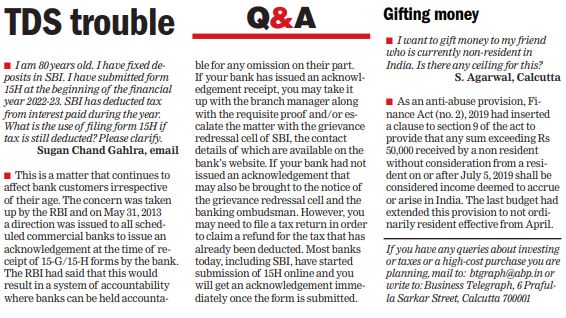Between the toss of the coin and the close of play resides an untold story. For purveyors of fixed-income, the story has just flipped in favour of deposits and debentures. Debt funds, now made bereft of their indexation advantage, are no more expected to be the happy hunting grounds for an influential category of investors.
Welcome to the competitive world of fixed-income options, now morphing rapidly to accommodate a series of challenges.
Deposits bearing superior interest rates as well as debentures and bonds that are yielding more will be pursued with considerable gusto by investors seeking suitable alternatives to debt funds.
While risks spawning from credit and interest rate changes do remain for them, viable options are not too hard to find. Issuers of debentures and bonds, for instance, are likely to woo this lot even more in the days ahead.
The average investor is expected to move away from frontline debt funds and allocate elsewhere with a view to generate periodic income.
However, liquidity may be compromised in the process as a number of alternatives will not be as liquid as debt funds. The latter allow easy and convenient exit at prevailing net asset values. There is no such mechanism at all for deposits. Further, not all bonds and debentures permit easy exit. Most are, in fact, subject to stiff conditions.
As for listed papers, a lot depends on trading interests and prices. For ordinary participants, the listed bonds space is not always the most perfect destination.
Risks
Risks, as I have mentioned earlier, are likely to emerge on two fronts. One, interest rates are changing rather quickly, a trend that may be seen in the context of the RBI’s extant policy on rates.
The repo, which serves as the central bank’s battle-axe in its fight against inflationary forces, has been increased several times in recent quarters. The fact that the latest inflation figure is characteristically over 6 per cent (reference: retail inflation recorded in February 2023), the apex bank may have to keep hardening rates yet.
Two, credit risk in general is not dissipating right away, it seems. On the contrary, there are certain signs of stress in the economic situation. However, no serious credit event is expected at this juncture.
The fixed-income investor will need to find his comfort zone between the two primary risks that I have just outlined. His investment strategy should be sufficiently accommodative. In other words, a diversified portfolio should be his chief pursuit. A smart mix of deposits (which carry fixed rates) and debentures (which may be listed, and, therefore, liquidity will be ensured) will be necessary.
Returns
What kind of returns can one expect from such a blend? As things stand, some popular deposits are now offering an annual 8 per cent or more. And certain debentures are known to be offering over 10 per cent to investors. While I will not comment on their creditworthiness, I must implore all to know about promoters’ credentials and track records. Jumping in just on the basis of superlative rates will probably create more problems than solutions. Far too many investors, blinded by extraordinary rates, have hurt themselves.
As for returns, an ideal portfolio should deliver a few notches above the current rate of inflation. Of course, taxation is a formidable issue too, and the post-tax numbers must be encouraging, to say the least. The challenge is especially steep for investors in the highest tax slab.
It is vital that returns are correctly gauged at the end of each financial period under consideration. Total returns — profits, in this case — are added to income and tax is levied on it. Returns will include both interest earned and profit on sale of securities.
Rules of engagement
A set of do’s can be worked out for an investor who wants to optimise his fixed-income exposure.
- He should aim at a broadbased basket of securities. There should be considerable variation in terms of issuer. Also, his time horizon is of utmost significance. Each security will have a life of its own, a distinct maturity profile. This should be in keeping with the investor’s own requirement.
- Credit rating must be accorded the importance it deserves. A portfolio comprising Triple-A rated issues is considered safe — that is, relatively safer than others carrying a mixed bag. Perhaps a conservative investor will prefer government securities, which are considered sovereign in nature.
- A more aggressive investor will probably want corporate bonds or debentures issued by non-government institutions. In the practical and competitive world, a perfectly AAA portfolio is not always desired. Investors are often tempted by the opportunities offered by, say, AA-rated instruments which are considered more lucrative.
- At all times, attention should be paid to the ongoing interest rate cycle. Right now, even as you read this on Monday morning, the cycle is in favour of stiffer rates. Central banks in major economies are tightening their strategies, and India is no exception. A series of upward revisions in the repo can be cited in this context.
- A regular vigil on industrial and corporate activity is recommended. Action taken by rating agencies is often a red flag for investors. Downgrades can damage their interests (read: portfolio quality), as they have done on many occasions in the past.
Overall, there is no reason why a well-oiled portfolio of deposits and other interest-bearing options cannot be construed. Many investors are expected to manage such a portfolio on their own in the future.
A timely word of advice from an investment professional will prove helpful. The investor concerned must also keep an eye on costs. Acquisition of securities and trading in them will invite brokerage and commission. Yet intermediaries such as brokers have to be given their dues. The wise investor must, at the end of the day, calculate his returns after all transaction costs are accounted for.
The writer is director of Wishlist Capital Advisors











